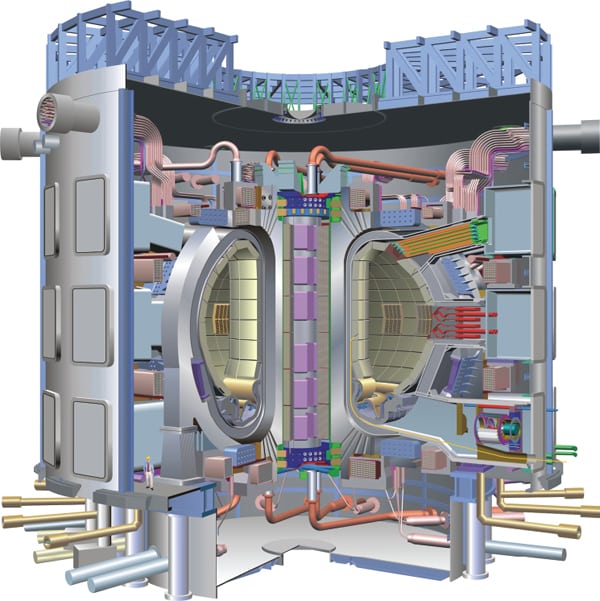ITER Gets New Life
The International Thermonuclear Experimental Reactor (ITER) in southern France, the world’s biggest nuclear fusion research project, is seeing a revival. After a budget shortfall last year and cost projections that continue to escalate, in September, the project got the European Parliament’s (EP’s) backing for an autonomous budget that seeks to guarantee transparent and reliable financing while limiting cost overruns. Japan also announced that it would increase its budget for ITER by 50% (the current ITER director-general is Japanese). Also in September, scientists announced that after an 18-month shutdown to upgrade the Joint European Torus (JET)—the world’s largest magnetic fusion device—the machine is ready to test materials to be used inside ITER (Figure 5).
 |
| 5. JET overhaul. Scientists plan to restart the Joint European Torus (JET)—the world’s largest magnetic fusion device— to test materials to be used inside ITER, the international nuclear fusion research project. This image shows a cross section of the device that will be used to demonstrate the technical feasibility of nuclear fusion as a source of power. Project partners include the European Union, Japan, China, India, South Korea, Russia, and the U.S. Courtesy: ITER Belgium |
Scientists started the first experimental campaign at JET, located near Oxford, UK, after installation of the “ITER-like wall.” The upgrade comprises new materials inside the JET vessel, more heating power, and additional diagnostic systems. JET’s researchers (like the ITER project in total) are also investigating the potential of fusion power as a safe, clean, and virtually limitless energy source for future generations. The research is coordinated under the European Fusion Development Agreement (EFDA).
“This is probably the largest effort that has been put into JET apart from the construction of the machine itself,” said EFDA Leader Francesco Romanelli. “With the expertise and contribution of many fusion laboratories, the JET team has succeeded in building a small ITER. We had a very good start with high purity plasmas readily established in ITER relevant conditions—a promising sign for the use of these wall materials in ITER.”
The inside of the JET vessel is now made of beryllium and tungsten tiles, forming an ITER-like wall. Between October 2009 and May 2011 engineers from Culham Centre for Fusion Energy removed and replaced approximately 86,000 components, largely using remote handling technology. Upcoming experiments will aim to verify that the wall materials chosen for ITER will behave as expected, the scientists said. Beryllium is being used in the main wall, whereas tungsten, with its high melting point, is the choice for the exhaust component known as the divertor, which has to withstand high heat flux.
The other main enhancement is a 50% increase in heating power. With the extra power, JET will achieve higher plasma temperatures and approach ITER conditions. New diagnostics and control systems, developed by the EFDA associate laboratories, will allow a deep investigation of the scientific challenges in preparing for ITER.
JET will be progressively brought up to full power to allow a proper investigation of the ITER materials under conditions approaching those of ITER. Future experiments include using the deuterium-tritium fusion fuel mix of ITER in 2015 to allow full exploitation of JET’s new capabilities. “We hope to set new performance records and provide the best possible preparation for ITER,” said Romanelli.
—Sonal Patel is POWER’s senior writer.